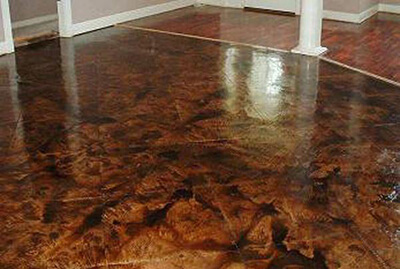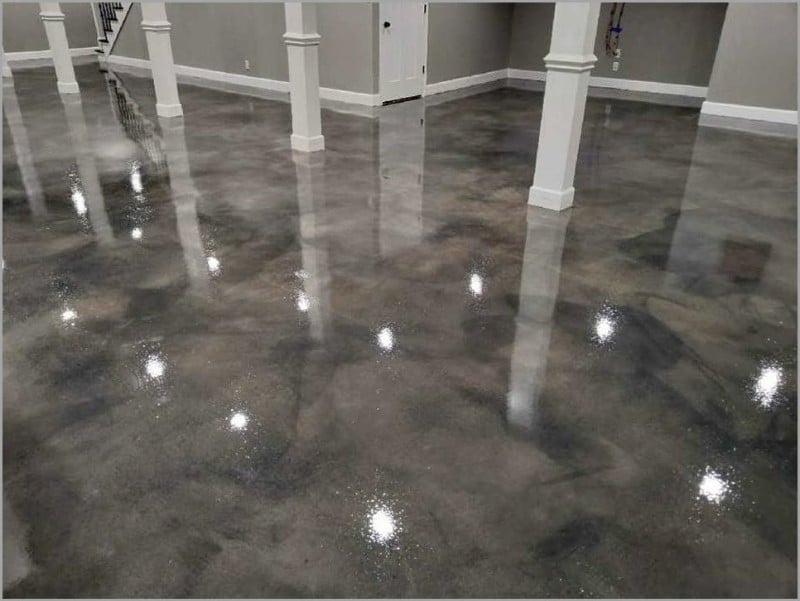Recognizing the Various Kinds Of Stained Concrete for Your Following Job
Stained concrete deals different alternatives that deal with various aesthetic and useful requirements. Each type provides distinct attributes that influence the final look and resilience of the surface area. Recognizing these differences is essential for anybody intending a project. From abundant, chain reactions of acid-based stains to the vivid harmony of solid shade stains, the choices can substantially impact the outcome. What variables should one think about when selecting the ideal tarnish for their particular requirements?
Review of Stained Concrete
Stained concrete functions as a functional floor covering option that can boost the aesthetic allure of different spaces. This technique includes using a coloring representative to the surface area of existing concrete, permitting a wide spectrum of style opportunities. Stained concrete is prominent in both residential and industrial settings, using a durable and low-maintenance option that can imitate the appearance of natural materials like stone or tile.
The staining process can be implemented utilizing water-based or solvent-based products, each giving distinct visual impacts. The last appearance is influenced by elements such as the initial concrete surface area, the kind of discolor made use of, and the application method. Stained concrete not only improves insides and outsides yet additionally advertises sustainability by revitalizing existing concrete structures. Therefore, it has actually gained traction amongst home owners and developers seeking both performance and style in their floor covering choices.
Acid-Based Stains: Qualities and Advantages

Unique Shade Variants
Concrete surfaces can transform significantly with the application of acid-based stains, which provide an abundant palette of distinct shade variants. These stains penetrate the concrete, reacting chemically to create dynamic planet tones that vary from deep browns and reds to soft greens and blues. The resulting colors are often variegated, producing a natural, marble-like appearance that boosts the concrete's personality. Each application yields unique outcomes due to variations in the concrete's make-up and the discoloration method used, making every project distinct. In addition, acid-based stains can be split or integrated with various other techniques to produce personalized layouts, enabling personal expression. This flexibility makes acid-based stains a prominent selection for both residential and commercial applications.
Chain Reaction Discussed
While lots of aspects add to the effectiveness of acid-based stains, the underlying chain reaction play a crucial role in their distinct features and advantages. These stains largely contain water, acid, and metal salts. When used to concrete, the acid reacts with the calcium hydroxide in the concrete, producing a chemical change that results in permanent color adjustments. The metal salts penetrate the surface area and bond with the concrete, permitting a wide variety of shades and tones. This response not just enhances aesthetic allure however likewise supplies longevity, making the shade immune to fading and wear. Furthermore, acid-based stains can create a variegated coating that mimics all-natural rock, further enhancing their appeal for ornamental concrete applications.
Surface Prep Work Value
Achieving ideal outcomes with acid-based stains depends upon comprehensive surface area preparation. This necessary action guarantees that the concrete surface area is clean, cost-free of impurities, and correctly profiled for perfect tarnish absorption. Any existing sealants, dust, or oils can hinder the chain reaction that creates the wanted shade and surface, leading to unequal or patchy outcomes.
Before using the discolor, the concrete needs to be mechanically cleaned or stress cleaned, complied with by a detailed evaluation for splits or flaws that might need fixing. In addition, confirming the surface area is effectively dried out will certainly improve tarnish adherence. By focusing on these preparatory steps, the longevity and vibrancy of acid-based stains can be greatly boosted, leading to a much more visually pleasing and durable coating.
Water-Based Stains: Attributes and Advantages

Water-based stains penetrate the concrete, supplying a more clear coating that highlights the natural structure and variants of the surface underneath. They are offered in a vast selection of shades, permitting for innovative adaptability in layout. In addition, water-based stains are less complicated to cleanse up, requiring just water and soap, which streamlines the application process.
Their fast drying out time enhances efficiency, making them a sensible choice for both do it yourself fanatics and specialists. On the whole, water-based stains provide an attractive combination of aesthetic convenience and user-friendly buildings, making them a popular choice for concrete improvement jobs.
Solid Color Stains: Lively Choices for a Vibrant Appearance
Strong shade stains offer an effective option for those looking for to develop a vibrant and vibrant aesthetic on concrete surfaces. These stains offer an uniform pigmentation that can dramatically improve the aesthetic charm of floorings, patio areas, and driveways. Readily available in a broad spectrum of hues, strong shade stains permit imaginative expression, catering to numerous style choices.
One of the crucial advantages of solid shade stains is their capability to conceal imperfections, providing a fresh and refined want to aging concrete - Stained Concrete Austin. In addition, their formulation typically includes UV-resistant buildings, making certain long life and shade retention also in extreme climate condition
Application is simple, calling for very little preparation of the concrete surface area. When used, strong color stains can be sealed for included protection and luster, additional elevating their aesthetic top quality. With their dynamic alternatives, solid shade stains are an exceptional selection for those aiming for an impactful and cohesive style.
Semi-Transparent Stains: Accomplishing Deepness and Dimension
Semi-transparent stains supply an unique method to improving concrete surface areas by supplying deepness and measurement with various shade choices. Understanding the application methods is vital for achieving the wanted effect, while correct maintenance methods guarantee durability. This area will discover these essential elements to maximize the benefits of semi-transparent discoloration.
Shade Options Available
A wide range of color choices exists for semi-transparent stains, permitting property owners and designers to improve the all-natural beauty of concrete surfaces. These stains can be found in an array of colors, from natural tones like browns and terracottas to lively shades such as blues and eco-friendlies. The semi-transparent nature of these stains permits the underlying concrete to reveal through, producing an one-of-a-kind deepness and dimension that can complement different layout visual appeals. Furthermore, incorporating different colors can produce personalized tones, allowing a customized seek each job. This adaptability makes semi-transparent stains a prominent choice for both exterior and interior applications, as they can harmonize with surrounding elements while adding aesthetic interest to ordinary concrete.
Application Methods Described
To attain the preferred deepness and measurement with semi-transparent stains, correct application strategies are essential. Surface prep work is critical; the concrete needs to be clean and totally free of any impurities. This usually entails power cleaning and repairing any kind of fractures. Next, choosing the appropriate applicator, such as a sprayer, roller, or brush, can affect the last appearance. Sprayers allow for a more also application, while rollers can assist achieve appearance. It is vital to apply the stain in thin, even layers, allowing each layer to dry prior to adding another. Adjusting the application strategy, such as varying stress or utilizing various devices, can produce distinct results. Lastly, sealing the stained surface area improves the vibrancy of the colors while providing security.
Maintenance Ideal Practices
Normal maintenance is essential helpful resources for maintaining the charm and integrity of surface areas treated with semi-transparent stains. To preserve these surface areas, routine cleaning is essential. Utilizing a pH-neutral cleaner and a soft-bristle mop will aid eliminate dust and debris without damaging the tarnish. It is advisable to prevent harsh chemicals, as they can degrade the discolor's look. Additionally, regular resealing each to three years can safeguard versus wear and fading. This procedure entails cleaning the surface thoroughly and using a compatible sealant designed for stained concrete. Home owners should also keep track of for any indications of staining or damage and address these concerns quickly to assure resilient vibrancy and longevity. Complying with these ideal methods will improve the general lifespan of semi-transparent stained surface areas.
Impacts and Methods: Personalizing Your Stained Concrete
Tailoring stained concrete involves an array of strategies that enhance both aesthetic appeals and performance. Amongst these approaches, layering various tarnish shades can produce deepness and complexity, enabling distinct visual effects. Techniques such as acid staining give a variegated appearance, while water-based stains provide an extra consistent look.
Additionally, incorporating attractive patterns, such as stenciling or inscription, can additionally personalize the surface area, adding intricate designs that accommodate individual preferences. Texturing the concrete, whether via stamping or broom surfaces, presents tactile elements that not just enhance hold but additionally improve visual interest.
Moreover, applying sealants can magnify the shade vibrancy and supply security against wear. Modification methods extend past simple shade; they can change a standard concrete piece into a stunning prime focus, making it suitable for both residential and business areas. Via cautious selection of impacts and techniques, stained concrete can attain a really customized appearance.
Upkeep and Durability of Stained Surfaces
Although stained concrete surface areas are known for their resilience and visual appeal, preserving their honesty is vital for ensuring durability. Normal cleansing is important; sweeping and mopping with a pH-neutral cleaner aids stop dirt accumulation and discoloration. Additionally, using a sealer every couple of years can safeguard the surface area from dampness, chemicals, and UV damages, thus boosting its life-span.
It is also crucial to deal with any kind of splits or chips quickly. Little fixings can mitigate further degeneration, maintaining the visual and structural high quality of the surface. For outside stained concrete, seasonal upkeep, such as getting rid of snow and ice, is essential to stop surface damage from freeze-thaw cycles.
Frequently Asked Concerns
Can I Discolor Existing Concrete Surfaces or Only Brand-new Ones?
The inquiry of whether existing concrete surfaces can be stained arises frequently. It is undoubtedly possible to tarnish both brand-new and old concrete, supplied the surface area is effectively prepared and devoid of impurities for excellent bond.
For how long Does the Discoloration Process Commonly Take?
The discoloration procedure normally takes one to three days, depending on aspects such as surface prep work, type of tarnish, and weather condition conditions. Stained Concrete Austin. Treating time may expand past first application, influencing the total duration considerably
Is Stained Concrete Safe for Outdoor Usage?
Stained advice concrete is typically secure for outside usage, offered it is effectively sealed. This sealing shields against dampness and UV damage, making sure sturdiness and safety, while likewise boosting the aesthetic allure of exterior rooms.
Can I Apply Numerous Discoloration Layers for Different Effects?
Applying numerous discolor layers can accomplish diverse impacts on stained concrete. It is necessary to guarantee compatibility between stains and enable appropriate drying time between applications to prevent unexpected reactions or staining.
Exist Any Type Of Shade Limitations for Stained Concrete?
Color restrictions for stained concrete visit site mostly rely on the type of discolor made use of, with water-based stains supplying a wider palette contrasted to acid-based stains. Stained Concrete Floors Austin Tx. Nonetheless, attaining vibrant shades may need cautious selection and application strategies